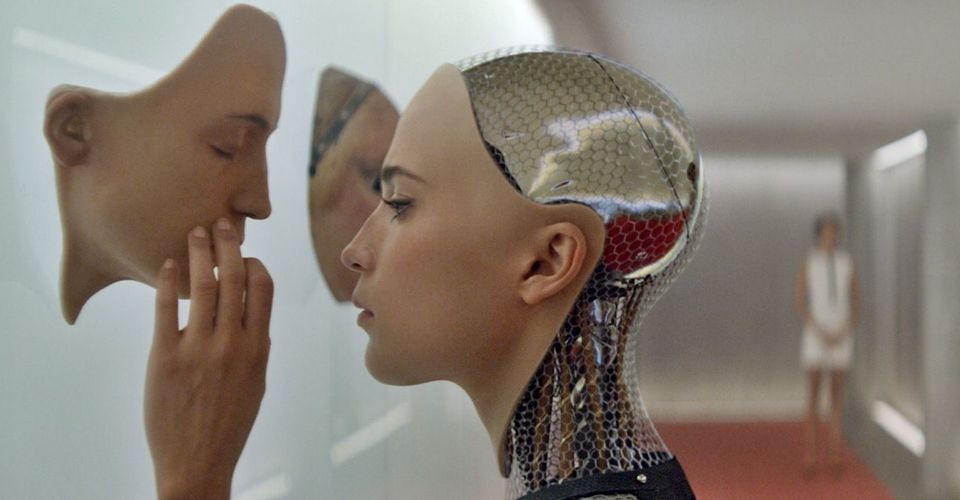10 Hidden Details Everyone Missed In Ex Machina

Ex Machina is one of the best and most compelling science-fiction films in recent memory. The small-scale film tells the story of a young man, Caleb (Domhnall Gleeson) who wins the opportunity to spend the weekend in a secluded getaway with the boss and genius inventor, Nathan (Oscar Isaac). But once there, Nathan unveils his stunning new project to Caleb – an A.I. being named Ava (Alicia Vikander).
Despite the intimate nature of the film, it is a gripping and tense exploration of humanity’s relationship with technology and where these advancements could lead. The movie is a brilliant and complex story that is fascinating to revisit for multiple viewings to see what you missed. Here are some of the hidden details in Ex Machina.
10 Near Future

Though Ex Machina is a science-fiction story, it doesn’t seem all that removed from the reality we live in now. That was an intentional aspect on behalf of the filmmakers. Writer-director Alex Garland didn’t want the film to feel like this distant and removed story, but rather something that was right around the corner.
In Garland’s explanation, he saw the advancements shown in the film as something that could be revealed any day now. While Ava might be a bit more advanced than that, the ideas of A.I., singularity, and surveillance through mobile devices are all concepts that are very real today.
9 Inspirations For Nathan

Oscar Isaac was probably the biggest name in the film at the time of Ex Machina‘s release. Though it was just before his huge role in StarWars, he was an established and acclaimed character actor thanks to films like Inside Llewyn Davis. He gives an outstanding performance as Nathan, a complex antagonist.
In order to create this unique character, Isaac was inspired by two particular figures, Bobby Fisher and Stanley Kubrick. Fisher was a world-renowned chess champion with a notoriously large personality, while Kubrick is the famed and celebrated film director. Isaac saw both men as elusive and mysterious geniuses.
8 Creating Ava

Perhaps the key to Ex Machina‘s success was in the depiction of Ava. She was at the center of the story and if we didn’t accept her as a character and as a stunning creation, the entire movie falls apart. This put a lot of pressure on both the design of the character and Vikander’s performance.
Though it can be difficult to play a robotic character without coming off as dull, Vikander did an amazing job. Her performance is even more impressive since she didn’t know what she would be looking like in the finished film. Vikander performed her scenes wearing a robot-like costume which was then replaced in post-production with the subtle yet important CGI additions.
7 Nathan’s House

The production design is another important factor that adds to the brilliance of the film. And one of the key elements of the production design was finding Nathan’s house. This proved to be difficult as the relatively low budget film needed to find an isolated mansion that could believably serve as a millionaire’s home.
The team tried to marry the idea of the home to its surroundings, hoping to suggest the scope of Nathan’s wealth based on the beautiful landscape his estate was on. This plan worked out perfectly as they found the usual Juvet Landscape Hotel in Norway which serves as the ideal location.
6 Black Mirror

The eerie feel and exploration of technology had many fans of the film comparing it to the popular series Black Mirror. That show also deals with the potentially harmful nature of modern technology in anthology stories. But that’s not the only connection Black Mirror and Ex Machina share.
In this film, Domhnall Gleeson plays a man who interacts and forms a relationship with an AI. However, Gleeson also appeared in an episode of Black Mirror entitled “Be Right Back” in which he played an AI who forms a relationship with a human woman.
5 Secret Code

Alex Garland has made a solid career with complex science-fiction films. Though his films can often be extremely thrilling, they are also incredibly dense and filled with big ideas. As a result, Garland likes to hide small nods to the work that influenced him inside his films.
Ex Machina features a lot of coding as you can imagine. While these codes in movies are usually just nonsense, some fans explored the code and found that it translated to a literary registration number for a book called Embodiment and the Inner Life: Cognition and Consciousness, which served as an inspiration for the film.
4 Biblical Names

Though the movie is exploring very modern concepts and drawing form modern works, Garland also drew some connections between the film and some very old stories. Fans have pointed out the biblical allusions within Ex Machina which can most obviously be seen in the names of the main characters.
Ava is a form of the name Eve who was, of course, the first woman that God created. Nathan was a prophet and Caleb was a spy sent to eventuate the Promise Land. You can find pretty clear connections between these characters in the bible stories and the characters in the film.
3 Star Wars

Gleeson and Isaac play off each other very well in this film which makes for some of the most intense and riveting scenes. They seem to play an intellectual game of cat-and-mouse throughout the story, always at odds with each other even if they aren’t saying it outright.
The two actors would get to revisit this antagonistic relationship in the new Star Wars trilogy, albeit reversed. In the Star Wars films, Isaac is now the hero, playing Poe Dameron while Gleeson is the villain, playing General Hux. It will be interesting to see if the two have a final confrontation in The Rise of the Skywalker.
2 Prisoners

The dynamics between Caleb and Ava are fascinating in the film and evolve with each new interaction they share with each other. Their “sessions” together are some of the most compelling moments in the film and the visual language of those scenes is very interesting.
The filmmakers wanted these scenes to feel as if Caleb was visiting an imprisoned Ava, but the layout of the meetings is very telling. They purposely made Caleb in a more confined space while Ava had an open space in which she could pace and move around. This could speak to the characters’ positions at the end of the film.
1 Machine Over Man

By the film’s conclusion, Garland has quite literally put man against machine and the question of who is playing who becomes much deeper. We discover that Ava has been influencing Caleb to trust her and secure her freedom, killing Nathan and trapping Caleb inside the home.
In Garland’s mind, the advancements in technology are building to the inevitability that humankind will become obsolete and that machine will eventually become superior. However, by his own admission and from what the film suggests, that may or may not be a bad thing.
About The Author


















